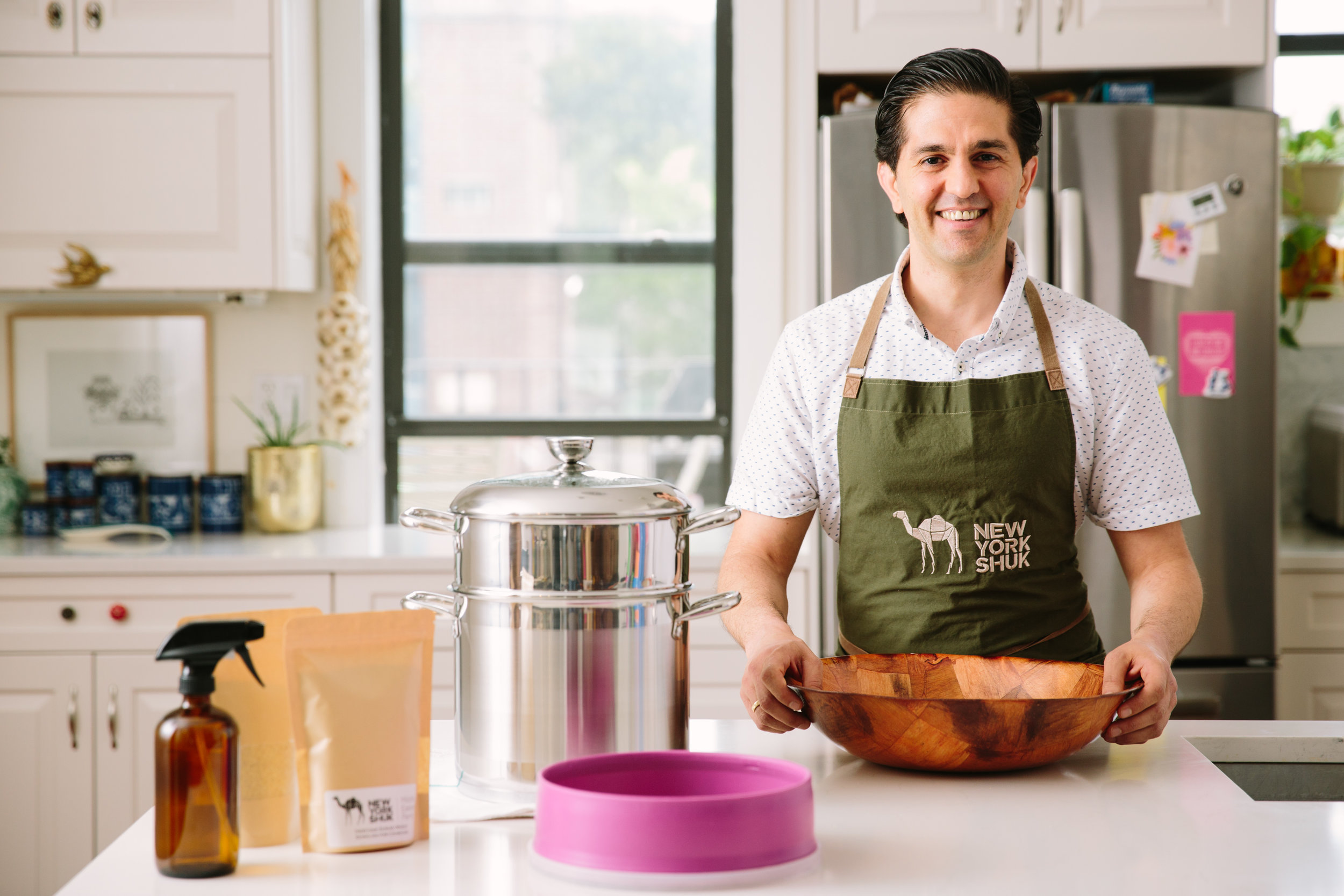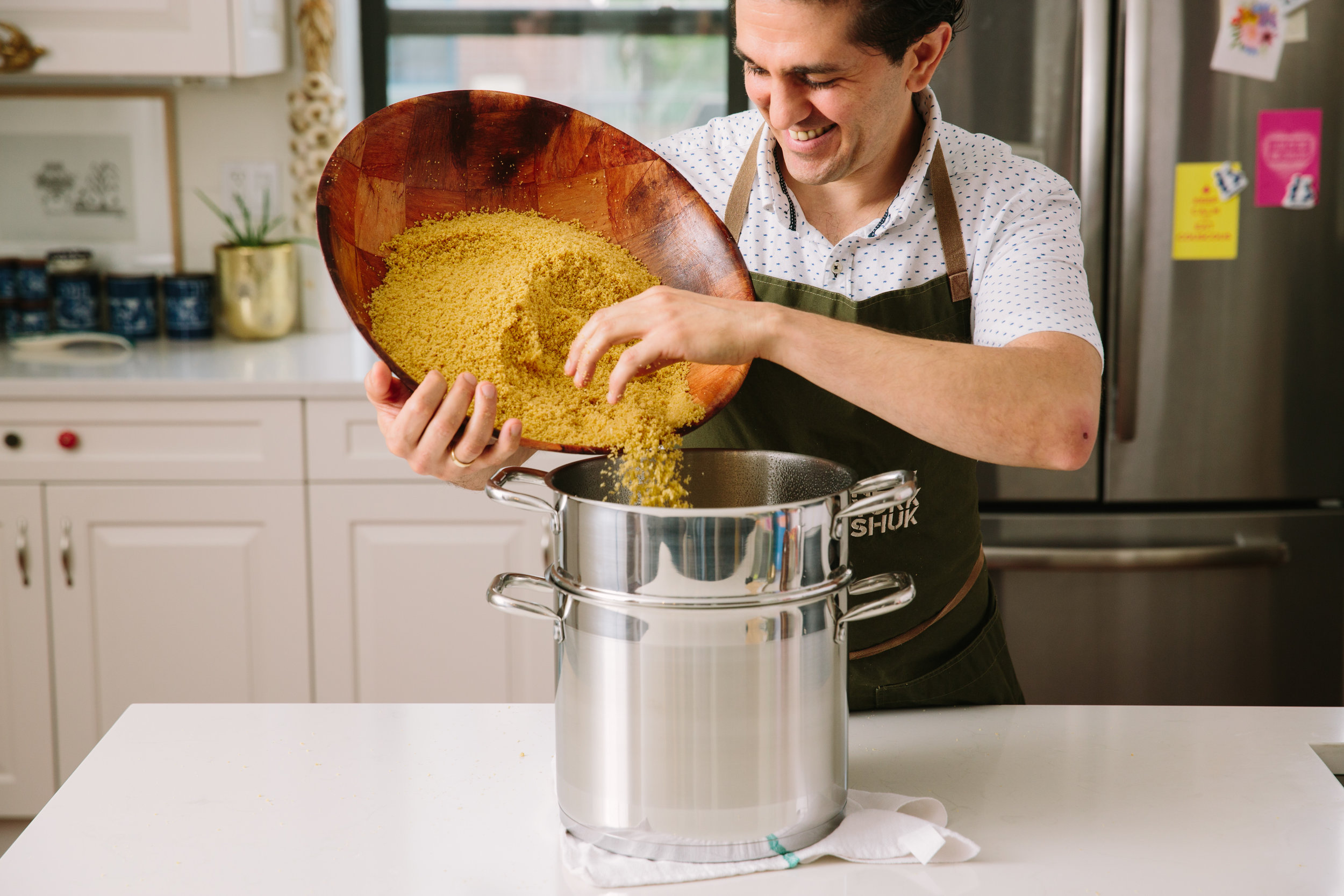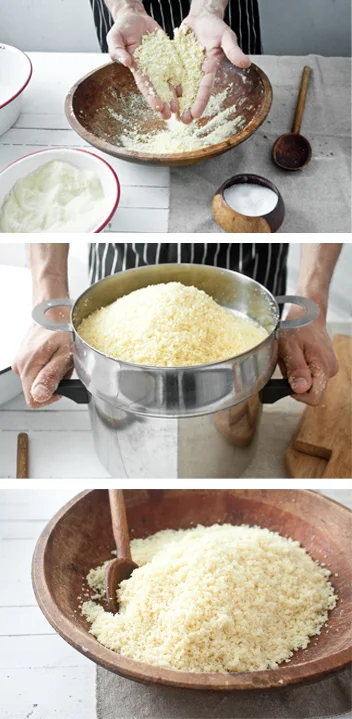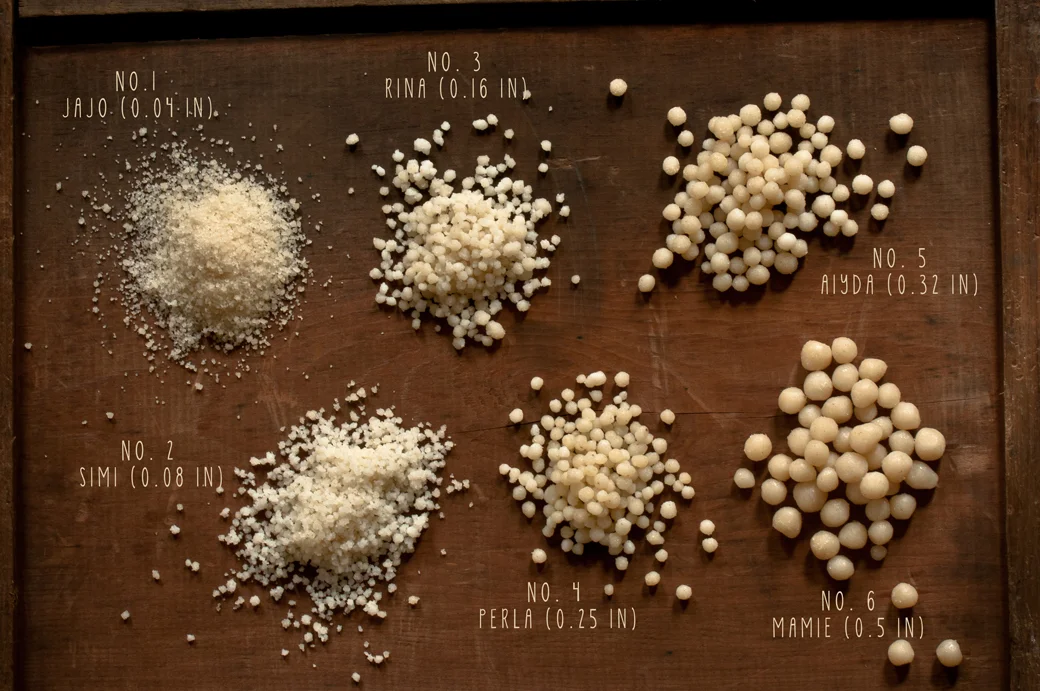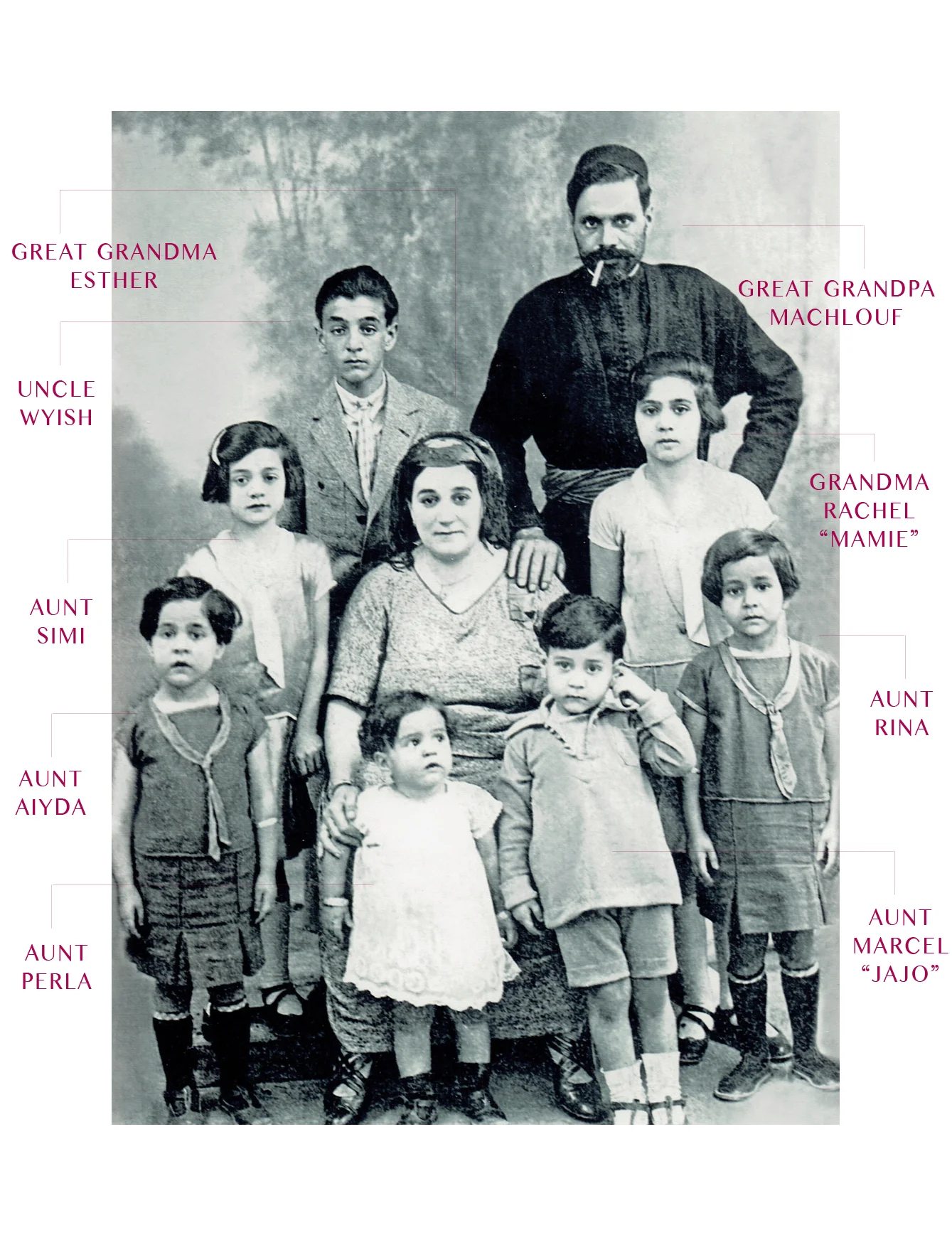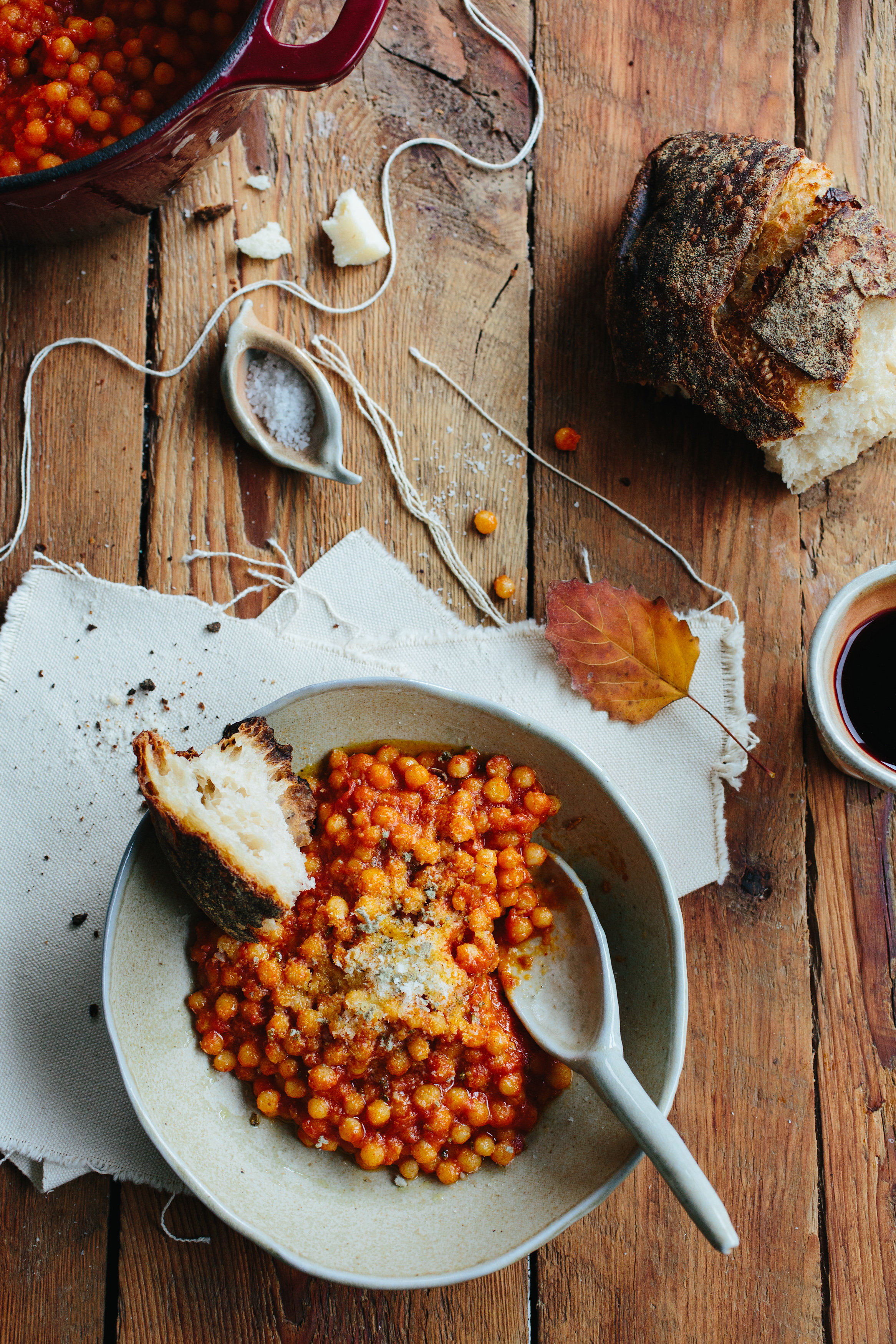SAY HELLO TO OUR COUSCOUS KIT {and to Ron}
The Art of cooking couscous is a symbol of craftsmanship.
It is a labor-intensive process of Semolina flour that is sprinkled with water and rolled with our hands to form tiny granules of couscous. Unfortunately, the art of couscous was lost to the processed instant supermarket couscous.
Ever since we arrived to NYC 5 years ago we have been on a mission to revive the lost culinary ritual of making couscous from scratch.
Sharing our passion for all things couscous has been at its core. From a couscous booth at Smorgasberg, to serving our couscous in some of NY finest restaurant to hosting classes in our Bed-Stuy home.
Now it’s YOUR time.
Join our couscous revolution.
In this couscous kit, we put together EVERYTHING you need to make couscous from scratch. Be a part of treasuring this culinary ritual for generations to come.
EACH COUSCOUS KIT INCLUDES:
Laguiole Couscoussier steamer
Ancient Durum Wheat Semolina- milled exclusively
for NEW YORK SHUK by Hayden Flour MillsA couscous sieve
Flat bottom bowl
A glass water spray bottle
Our very own Hand Rolled Couscous recipe; including an in-depth Q&A section, a thorough step by step recipe guidelines-all accompanied by pictures and a short video to illustrate the process
{MORE DETAILS BELOW...}
LAGUIOLE COUSCOUSSIER STEAMER POT
Throughout the process of making couscous from scratch the couscous is steamed 3-4 times. Making a couscoussier an essential part of the process. Laguiole Couscoussier steamer set is imported exclusively for NEW YORK SHUK from France. The set includes a seven-layer base, aluminum core, and stainless-steel layer pot with a compatible steamer insert.
When making an israeli couscous recipe from scratch it should be savored accordingly and be the center of the meal and not a side note. Transform your steamer pot into a serving piece ready to be carried to the table for everyone to admire and appreciate.
Last but not least, both the pot and the steamer can be enjoyed for an array of uses outside the realm of couscous making. Making soups & stews, steaming vegetables and fish has never been easier.
Laguiole
France’s most trusted makers of cookware. Crafting bespoke kitchen ware for specialty stores around the globe. Thanks to their timeless design, classic style and instantly recognizable heirloom quality, these are the perfect tabletop tools to choose for a lifetime of use.
Details:
2 in 1 product: pot and couscoussier
Optimal heat distribution
Thermal bottom, consisting of an aluminum layer and a layer of stainless steel, makes it possible to diffuse heat ideally throughout when cooking vegetables, meats and semolina. Moreover, such a coating makes it possible to preserve the natural properties of your food
Made of: 18/8 stainless steel
Brand: Gam’Hotel
Size: 8.5-quart(4L) pot is 9.45” in diameter x 9.45" H; 4.25-quart(4L) steamer insert is 9.45” in diameter x 3.94” H –fits up to 5 lb of couscous in it.
Sourced from: Laguiole- France, imported exclusively for NEW YORK SHUK
Care: dishwasher safe, although hand washing is recommended. Oven safe to 500° F and suitable for all cook-tops.
WATER SPRAY BOTTLE
True, you are not going to see any grandma spraying her semolina with a spray bottle but when working on perfecting the technique needed to make couscous from scratch during the last few years we noticed that this seemingly modest kitchen equipment became an indispensable part of trying to achieve the best result.
Using the spray bottle gets an even layer of water on the surface of the semolina in the bowl, which helps us roll faster and in a more efficient way. Will the couscous taste any different if you would choose to flick the water with your fingers? No, but making couscous is a laborious process to begin with so our aim is to help you top the traditional ways in ease, efficiency, and result.
Made of: amber glass, plastic nozzle
Size: 3” x 6”
Care: glass bottle is dishwasher safe, plastic nozzle hand wash recommended
HARISSA!
We Can't have you enjoying freshly made couscous without our signature harissa : )
ANCIENT DURUM WHEAT SEMOLINA
We source our semolina from the fine folks at Hayden flour mills in Arizona, where the ancient durum wheat grain is grown, harvested and milled to the special ‘couscous’ semolina size we created in order to achieve the perfect couscous.
Non-hybridized, minimally processed and flavorful semolina is crucial to get the most of your couscous. The incredible flavor of the semolina with so much character and aroma gives an unmatchable result.
Semolina: heritage durum variety of semolina called Blue Beard Durum known for its incredible flavor!
Size: 2 x 16 ounce bags
Sourced from: Hayden flour mills- a family business that is devoted to making the freshest and most flavorful flours from some of the world's oldest varieties of wheat.
Best by: for the absolute best results use within six months of the packing date or place in the freezer for better longevity
A COUSCOUS SIEVE
A couscous sieve has a much larger mesh size then a regular sieve and it plays an important part in creating the fluffy texture we are looking for when making hand rolled couscous.
The first role of the sieve is to help us get an even “grain” size when rolling the couscous. The second part of the sieve is to get rid of the irregular cooked particles at the end of the cooking. The result is the silkiest, softest bowl of couscous you have ever eaten.
Made of: Stainless steel mesh, plastic frame
Size: 10" diameter
Made in: Israel, private import
Care: hand wash only. Frame and mesh can be separated for an easier clean
FLAT BOTTOM BOWL
The sole purpose of working with a flat bottom bowl is to make the rolling process a lot easier. The first vital part of a flat bottom bowl is to create more surface space for the rolling process, something that is very hard to achieve with a regular kitchen bowl. Furthermore, we choose to work with a lightweight material to make it easy to carry and lift throughout the process, both when rolling and mixing and also when we need to get the semolina in and out of the steamer. It’s these little things that can help make the middle eastern couscous rolling process more efficient.
Made of: woven wood
Size: 16 " diameter
Care: hand wash only
Our very own Hand Rolled Couscous recipe; including an in-depth Q&A section, thorough step by step recipe guidelines - all accompanied by pictures and a short video to illustrate the process
In this section we are not holding back! We will be sharing with you all of the steps, advice and tips to make the perfect hand rolled couscous at home. We gathered the most frequently asked questions from our Art of Couscous classes to share with you. Seeing the process through images and video will help you better understand the traditional old time technique of making couscous from scratch.
Please Note:
Currently unable to accept returns or offer refunds on the couscous kit.
If you'd like to contact us regarding your order, please email info@nyshuk.com within 7 days of receiving your order.
Read more about our couscous story:
WHAT IS COUSCOUS?
Throughout North Africa and parts of the Middle East, couscous is regarded as the ultimate comfort food. Like rice to Persian cuisine or pasta to Italians, couscous is revered as almost sacred - a food to enjoy every day, and to dress up for special occasions.
Deriving from the Berber word seksu, which means well-rolled or rounded, couscous resembles a whole grain like wheat or barley, but is actually a mixture of semolina (cracked middlings of durum wheat), water, salt and oil or samna (clarified butter) that gets rubbed together until it forms small granules that are then steamed. Like snowflakes, every piece of hand-rolled couscous has its own unique shape and composition.
Today, most people only know the factory-produced version that comes in a box with a flavor packet tucked inside. But at its heart, couscous is the opposite of fast food. It is made by hand and savored accordingly.
COUSCOUS: HISTORY AND CULTURE
There are different theories about how couscous came to be. The dominant story is that it is an ancient dish invented by the Berbers –indigenous North African tribes – that later spread to other countries. In “The Great Book of Couscous”, Copeland Marks writes that during the conquest of North Africa by the Romans, part of the area was turned into the empire’s breadbasket where all of the cereals were grown. This helps to explain how a desert-dwelling people could have taken on the practice of working with semolina.
In terms of technique, Gil Marks writes in The Encyclopedia of Jewish Food how, by the eleventh century, the Berbers began to use an ancient African cooking technique of steaming foods in woven baskets to “develop a process of steaming semolina.”
What is certain is that, before long, the practice of making couscous took root throughout the Maghreb.
Over the centuries, it has evolved into much more than just food, it is woven into the fabric of communities. In North Africa, births, weddings, and other lifecycle events and auspicious occasions (even moving into a new home!) are celebrated with couscous. Served family-style, everyone joins together in eating. In that way, couscous both figuratively and literally brings people together.
HOW WE MAKE OUR COUSCOUS
The process of making couscous is both simple and sophisticated. Traditionally, women from an extended family and sometimes neighbors would come together to prepare couscous. In addition to feeding their families, it was a time to catch up on community news, and bond with one another. As a child in Morocco, Ron's mother, Linor, learned to make couscous almost by osmosis, running in and out of the kitchen with her siblings while it was being prepared. Growing up in Israel, Ron developed a deep love and appreciation for the hand-rolled couscous of his heritage. Today, we strive to remain true to the traditional practice, while bringing a chef's sensibility to the mix.
We start by adding semolina to a large bowl, spraying it lightly with salted water, and rolling it between our fingers until it begins to form into tiny clumps. This process of spritzing and mixing continues little by little until the couscous has the right size, moisture-level, and texture. There's no exact israeli couscous recipe to follow - just like Ron's mother and grandmother, we rely on the feel of the granules against our palms to tell us when it is ready.
Next, the couscous gets sifted through a round mesh sieve; the tiny grains falling through into a bowl below, while the larger and irregular grains are left behind. If we are making our smallest couscous, No 1. (Jajo), we coat it in a tiny film of oil and then it gets transferred to a special double-decker steamer called a kiskis in Moroccan or couscoussier in French and gently steamed three times until it is airy and light with just the tiniest whisper of a bite. If we are making one of our larger couscouses, we continue the process, adding more water, sprinkling on more semolina as needed, and rolling, rolling, rolling to slowly increase the bulk. Through this elemental process, we are able to turn out an incredible diversity of couscous sizes and textures.
If the thought of moroccan couscous does not excite you, we'd like to think it is because you have not yet had an opportunity to try ours. Unlike the boxed "just add water" versions, our couscous is moist and deeply flavorful and so much more than the sum of its parts. Our traditional hand-rolling technique produces couscous grains with texture and personality, and allows us to offer six different sizes from tiny and fluffy to chewy and marble-sized.
By using just four simple ingredients (semolina, water, salt, and canola oil) and serving it fresh (never dried), our moroccan couscous maintains a brightness that stands out in every spoonful. Forget all you have learned about moroccan couscous recipe in the past - forget the boxes and the flavor packets. Our goal is to help you discover couscous as it was meant to taste.
SIX GIRLS, SIX COUSCOUS SIZES - A PERFECT FIT!
We make six different hand-rolled couscous products, ranging from very tiny to our special, marble-sized couscous. The larger the grain, the longer and more labor intensive it is to make. When deciding what to name our couscous, we made the connection that Ron's Moroccan grandmother, Rachel ("Mamie"), had five younger sisters. Six girls, six couscous sizes - a perfect fit!
No.1 - Jajo (0.04 in)
This is the smallest, lightest and fluffiest couscous size we make. It is the preferred size for most Tunisian tables.
No.2 - Simi (0.08 in)
This is the mostly widely-known size of couscous and is often described as "Moroccan" couscous. It has just a touch more bite than No 1.
No.3 - Rina (0.16 in)
Just a bit larger than No. 2, this couscous has a lovely texture and firmness that works perfectly in tabbouleh and other grain-based dishes.
No.4 - Perla (0.25 in)
The firm texture and round shape of this couscous lends well to either steaming or warming up in a broth or sauce.
No.5 - Aiyda (.32 in)
This couscous, which has a perfectly spherical shape, is similar in size to what is known as "Moghrabieh" in the Middle East. It is traditionally served in stews or soups.
No.6 - Mamie (0.50 in)
Our largest couscous has a unique texture and is distinctly dense and chewy texture.
COUSCOUS INSPIRATION
'Perla' Salad- couscous No.4 with white fish, herbs, raw zucchini in a cured lemon dressing. Photography: Christine Han, Ceramics: Shino Takeda
Couscous No.6 'Mamie" in a vegetable soup with lamb meatballs.
Photography: Christine Han, Ceramics: Shino Takeda
Couscous No. 5 'Aiyda' in a tomato & Harissa sauce topped with grated parmesan and dried sage.
Photography: Christine Han, Ceramics: Shino Takeda
Couscous No. 1 Jajo served as a sweet morning dish with dried fruit preserve, roasted almonds, cinnamon and hot spices milk.
Photography: Christine Han, Ceramics: Shino Takeda
Couscous No. 2 FEAST.
'Simi' couscous, vegetable soup, braised vegetable, turmeric chickpeas, spiced cornish hens. Photography: Christine Han, Ceramics: Shino Takeda
COUSCOUS FAQs
For a relatively simple food, there is a decent amount of confusion out there about couscous.
In hopes of clearing things up, here are the facts:
Is couscous a pasta or a grain?
Technically speaking, couscous is neither a grain nor a pasta. It has too many components to be a simple grain like wheat or barley. Unlike pasta, it is not made from a proper dough and gets steamed instead of boiled. It is its own unique product.
What are fregola, moghrabiah, and maftoul? Are they couscous?
Think of these foods, which are often used interchangeably, as in the couscous family. Fregola is a small Sardinian pasta that resembles pearl couscous, but with a less even shape. It is made from semolina and water but gets dried and toasted, which gives it a nutty flavor.
Moghrabiah, which hails from Lebanon, is also a larger version of couscous (bigger, even, than fregola) that gets cooked and served as part of a stew or soup. Its density and chewiness allows it to gracefully maintain its texture when cooked in a liquid.
Maftoul, known as Palestinian couscous, is made with a similar technique, but with bulgur wheat and flour. First you soak the bulgur with water. Then you add the flour and roll the two together into a round shape. It is typically steamed before being added to a rich stew.
Is couscous the same everywhere?
There are regional differences depending on where the couscous is being made and served. Tunisians, for example, typically prefer their couscous tiny and fluffy, while Moroccans like it a little larger and more textured. Meanwhile, every family has their own preferred method of preparing it, which makes couscous one of the most diverse and delicious dishes in the world.
What binds all couscous variations together are the ingredients and technique used to make them. Couscous is made from semolina, water, salt, and fat (either oil or a clarified butter called samna). And the semolina is always rolled by hand while adding in the water very gradually.
What is Israeli couscous?
Israeli couscous, while delicious, is also more of a cousin to couscous than actual couscous. It is a small, pellet or rice-shaped pasta, similar to orzo, made from wheat flour and water, and gets toasted before it is cooked. It was born in the 1950s when David Ben Gurion commissioned the Israeli food company, Osem, to create an alternative to rice. Called ptitim (or "little crumbles") in Israel, it became hugely popular there and has since spread to America, where it took on the name Israeli couscous.
How Do You Eat Couscous?
In America, couscous is typically regarded as a side dish - a starch sitting on the side of the plate. But in North Africa and the Middle East, it much more versatile and central to the meal. It can be served savory or sweet, and either alone or as a component of a larger dish. In North African countries, it is often accompanied by a meat or vegetable stew.
Moroccans treasure a couscous dish served with a vegetable stew, typically a mix of root veggies and squashes. Algerians, often add tomatoes to their couscous stews. In Libya, it is sometimes made with millet instead of semolina and most often served with lamb. Tunisians, meanwhile, like to liberally spice up their couscous with Harissa, and serve it with a brothy fish bouillabaisse.
On the sweet side, Moroccans serve very fine, fluffy couscous doused with milk and flavored with cinnamon, orange blossom water, sugar, and almonds. Libyans and Egyptians also eat couscous as dessert - the former with dates, sesame, and honey, and the latter with butter, cinnamon, cream, and raisins. No matter what accompanies it, the most important aspect of couscous is that it is served communally. It is meant to be shared and savored along with laughter and conversation.
Testimonials
My grandfather was Tunisian, so I had the pleasure of eating a lot of very good couscous growing up - but today it is hard to find. What I like about Ron and Leetal's couscous is how they have fully devoted themselves to reviving and delivering the flavors and cultural heritage of a traditional dish. I have seen people sample it and say, "Wow," as if they are discovering it for the first time. NYShuk shows how something as simple and basic as couscous can be luxurious and refined when you do it the right way.
Lior Lev Sercarz |
Spice blender and owner of La Boîte | NYC
I am what you can call a connoisseur of couscous. I was born in Algeria and my grandmother rolled and steamed her couscous by hand. That is precisely what makes Ron's couscous so feathery and delicious. He is the only chef I have found in the States that makes couscous this traditional way. I first discovered NYShuk at Smorgasburg in Brooklyn, and thought their couscous was so delicious, my wife and I hired Ron and Leetal to cater two parties for us!
Pierre-Yves Azuelos | NYC

